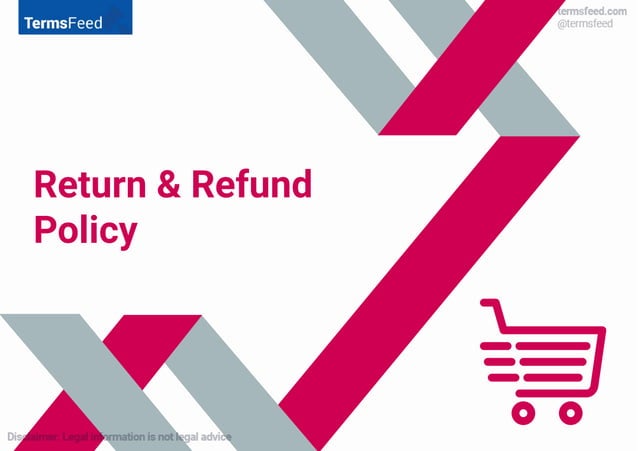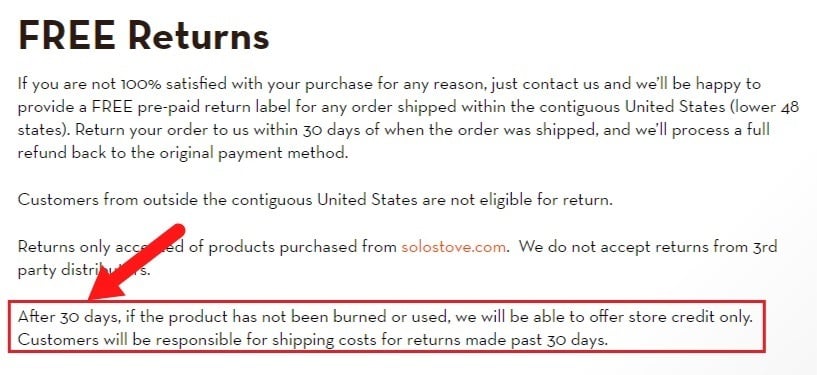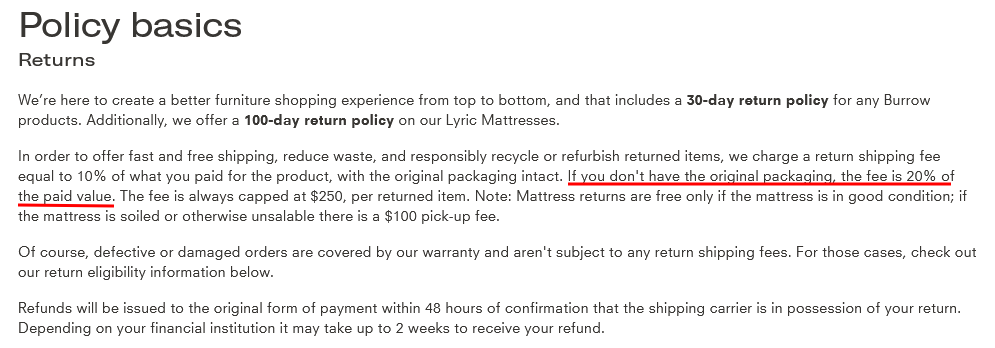-
What are Return and Refund Policies?
A Return and Refund Policy is a policy that dictates under what conditions customers can return products they've purchased from your ecommerce store and whether you'll reimburse them or not. It will also let your customers know the time frame within which your company can accept returns.
What are Return & Refund Policies from termsfeed

Why are Return and Refund Policies Important?
Return and Refund Policies for ecommerce stores have been proven to increase the number of people who end up making a purchase once they're on your website.
In addition, having a Return and Refund Policy in place can help reduce your expenses when it comes to return deliveries. For instance, consider the fact that in the United States alone, Statista's statistics show that return deliveries cost businesses $550 Billion between 2017 and 2020.
That's a 75.2% increase over five years ago.
People are often hesitant to buy online, which can lead to low conversion rates and sales. Having this policy helps alleviate some of that hesitation since they know they can return the product and get a refund if their expectations aren't met while making a not-in-person purchase.
Of course, customers may be unhappy with their order for many reasons. It might arrive damaged, it was the wrong size or it didn't meet all their expectations. They may request a refund or a replacement.
These requests can be overwhelming without a system to handle them. Think of all the time necessary to handle customer service emails and the money your company may have to spend to replace the returned product. Now think about those expenses just after Black Friday or Christmas!
Thankfully, the solution is relatively simple. You can make returns and exchanges less of a problem by writing and posting a solid Return and Refund Policy for your website. Moreover, you can help increase customer loyalty and potentially generate new revenue by doing so.
Standard Ecommerce Return Rates
There is no single return rate for ecommerce that you should accept as typical. Return rates for ecommerce vary greatly by product category. Indeed, no two industries are the same.
With that said, some statistics show average return rates for certain product categories, such as the following:
- Clothing and shoes: 30 to 40%
- Food: 7%
- Furniture: 5%
- Home electronics: 10%
- Average of all ecommerce returns: 15-30%
-
Evidence shows that ecommerce stores with lower volumes are inclined to have lower returns than those with greater volume. This may be a result of the fact that more established ecommerce businesses tend to have more flexible Return and Refund Policies, or because consumers feel less guilty about returning products to corporations than they do to small-scale online stores.
Regardless of the size of your operations, it can be hard to decide the right approach for your business with regard to your Return and Refund Policy.
Many ecommerce companies can't afford to offer free returns like big online retailers. However, that doesn't mean you can't provide your customers with a policy they'll appreciate.
Are Return and Refund Policies Legally Required?
The United States doesn't have a federal law which governs returns or refunds. No state laws require one either, although some states do have regulations about where you must place your policy if you choose to write one. There are also laws in the EU that deal with returns and refunds.
Even if you aren't required by law to have one, there are still good reasons to put a Return and Refund Policy in place.
For example, your customers expect to be informed about your policies and to know that you'll adhere to terms that have become commonplace within the ecommerce industry.
What to Include in Your Return and Refund Policy

Your Return and Refund Policy should include important details about when you accept returns, what the conditions of return are, and how you issue refunds.
Remember that people are not inclined to read lengthy and boring legal documents online. However, it is vital to give all necessary information.
It's a good idea to divide your Return and Refund Policy into smaller parts. This will make the document easier to read, help customers find what they need, and protect you legally.
When considering what to put in your Return and Refund Policy, think about the fact that there are many advantages to ensuring it is customer-centric. Innovative businesses know that a customer-centric return program is an effective marketing tool.
For instance, as reported by the UPS in 2017, 68% of online shoppers verify a website's exchange and return policy before they make a purchase. Many brands advertise that they offer "free," "easy," and "no-hassle exchanges and returns to increase conversion rates.
In other words, the evidence shows that businesses that have a Return and Refund Policy that benefits customers often have higher return purchase rates than those which do not.
A return or exchange may actually cost a business on the first purchase. However, a better customer experience will lead to higher retention rates and long-term revenue growth.
To ensure that happens, here's what you need to know about how to create your Return and Refund Policy.
Keep the Language of Your Policy Clear and Simple
Before we get into what you should include in your Return & Refund Policy, here's a general rule to keep in mind:
- Write the same way that you speak (normal, flowing language and not legalese)
- If you're not a lawyer, don't pretend to be one
- Even if you hire a lawyer, speak with that individual and get them to legally binding language that customers understand and give your Return and Refund Policy a personality
-
Your Return and Refund Policy should be good to go as long as you ensure the writing is clear, concise, and not open to interpretation.
Specify a Time Frame for Returns
Letting your customers know precisely how long they have to return a product is a crucial element to include in your Return and Refund Policy. Typically, ecommerce stores offer a 15- to 30-day window in which customers can return a product and ask for a refund. Some businesses extend that period up to 90 days.
Notice how Solo Stove specifies that it will only provide customers with in-store credit if returns are made after 30 days:

Regardless of the time frame you choose, ensuring that you actually have a time frame is essential. You don't want people trying to return products or demanding refunds months or years beyond the date of purchase.
Some larger stores learned this lesson the hard way.
Define the Conditions Under Which You'll Accept Returns
When you are writing your Return and Refund Policy you should ensure that you include a section that outlines under what specific conditions you'll accept returns and make refunds.
If your customer is immediately unhappy with a purchase or if the product isn't working correctly, accepting a return and providing a refund may be reasonable. However, it's quite another thing when the buyer uses, damages, or alters the product, and over a longer period of time.
For instance, this is how Burrow states that its customers are subject to a 20 percent service fee if returns are not in the original packaging:

If you don't include that information, your customers might try to return whatever they bought in a condition that makes a resale impossible. In that case, you'd obviously have to absorb a loss.
Return Requirements
You need to let your customers know ahead of time if there are any requirements they need to meet before you can process their returns.
By way of example, if they must ensure that all products are returned unopened and in their original packaging, that's something you should state explicitly in your Return and Refund Policy.
Other common conditions include things such as customers needing an:
- Authorization number
- Purchase receipt
-
Whether it's these or other criteria, you should clearly state what they are. A system to handle returns, which has become common in recent years, is a Return Merchandise Authorization (RMA) system.
This system allows you to ask your customers for information and images of the products they wish to return. Once you review the information and pictures, you can choose to either accept or deny the return. It also allows you to provide your customers with a shipping label once you've made an authorization.
Choose In-Store Credit or Refund
Before they return a product, customers want to know what your compensation plan is. Some customers will ask for a full refund, while others may accept in-store credit. If you run an ecommerce store, you have to choose between the two options.
Here's how Natori specifies its use of in-store credit:
